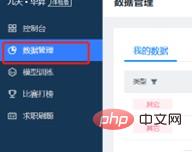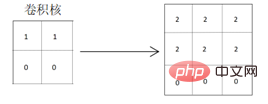Home >Technology peripherals >AI >TensorFlow application technology expansion—image classification
TensorFlow application technology expansion—image classification
- 王林forward
- 2023-04-18 16:07:031839browse
1. Scientific research platform environment deployment operation expansion
For model training in machine learning, I recommend that you learn more official TensorFlow courses or resources, such as the two courses on the Chinese University MOOC《TensorFlow Introductory Practical Course》and《TensorFlow Introductory Course - Deployment》. For distributed training of models involved in scientific research or work, a resource platform may often be very time-consuming and unable to meet individual needs in a timely manner. Here, I will make a specific expansion on the use of the Jiutian Bisheng platform mentioned in the previous article"Preliminary Understanding of TensorFlow Framework Learning"to facilitate students and users to more quickly Carry out model training. This platform can perform tasks such as data management and model training, and is a convenient and fast practice platform for scientific research tasks. The specific steps in model training are:
(1) Register and log in to the Jiutian Bisheng platform. Since subsequent training tasks require the consumption of computing power beans, the number of computing power beans for new users is limited, but they can be shared by Friends and other tasks to complete the acquisition of computing power beans. At the same time, for large-scale model training tasks, in order to obtain more model training storage space, you can contact the staff of the platform by email to upgrade the console, thereby meeting the training storage requirements required in the future. The details of storage and computing power are as follows:

(2) Enter the data management interface to deploy the data sets used by the scientific research project model, and perform the data set required for scientific research tasks. Package and upload to complete the deployment of the data sets required for model training on the platform.

(3) Add a new project training instance in the model training window, select the previously imported data set and the required CPU resources. The created instance is a single model file that needs to be trained for scientific research. The details of the new project instance are as shown below:


(4) Run the newly added project instance, that is, run the project training environment , after running successfully, you can choose the jupyter editor to create and edit the required code files.


(5) Subsequent code writing and model training can be performed using the jupyter editor.
2. Image classification technology expansion
Image classification, as the name suggests, is to judge the categories of different images based on the differences between images. Designing a discriminant model based on the differences between images is knowledge that needs to be mastered in machine learning. For the basic knowledge and operation process of image classification, you can refer to the "TensorFlow Introductory Practical Course" on the Chinese University MOOC to quickly understand the basic application and design ideas of TensorFlow. . https://www.php.cn/link/b977b532403e14d6681a00f78f95506e
This chapter is mainly intended to introduce students to this course by expanding image classification technology. Users gain a deeper understanding of image classification.
2.1 What is the use of convolution operation?
When it comes to processing or classifying images, one operation cannot be avoided, and this operation is convolution. Specific convolution operations can basically be understood through learning videos, but more readers may only stay at the level of how to perform convolution operations, and why convolution is performed and what is the use of convolution operations are still unclear. A little knowledge. Here is some expansion for everyone to help you better understand convolution.
The basic convolution process is shown in the figure below. Taking the image as an example, a matrix is used to represent the image. Each element of the matrix is the corresponding pixel value in the image. The convolution operation is to obtain the eigenvalues of these small areas by multiplying the convolution kernel by the corresponding matrix. The extracted features will differ due to different convolution kernels. This is why someone will perform convolution operations on different channels of the image to obtain the features of different channels of the image to better perform subsequent classification tasks.

In daily model training, the specific convolution kernel does not need to be manually designed, but is automatically trained using the network by giving the real label of the image. However, this process is not conducive to people's understanding of the convolution kernel. The kernel and convolution process are not intuitive. Therefore, in order to help everyone better understand the meaning of convolution operation, here is an example of convolution operation. As shown in the matrix below, the numerical values represent the pixels of the graphic. For the convenience of calculation, only 0 and 1 are taken here. It is not difficult to see that the characteristics of this matrix graphic are that the upper half of the graphic is bright and the lower half of the graphic is black, so the image There is a very clear dividing line, that is, it has obvious horizontal characteristics.

Therefore, in order to well extract the horizontal features of the above matrix, the designed convolution kernel should also have the attributes of horizontal feature extraction. The convolution kernel that uses vertical feature extraction attributes is relatively insufficient in the obviousness of feature extraction. As shown below, the convolution kernel that extracts horizontal features is used for convolution:

It can be seen from the obtained convolution result matrix that the horizontal features of the original graphics are well extracted. out, and the dividing lines of the graphics will be more obvious, because the pixel values of the colored parts of the graphics are deepened, which can well extract and highlight the horizontal features of the graphics. When convolution is performed using a convolution kernel that extracts vertical features:

# It can be seen from the obtained convolution result matrix that the horizontal features of the original graphics can also be extracted, but Two dividing lines will be generated. The graphics change from extremely bright to bright and then to black. The situation reflected on the real graphics will also change from light to dark to black, which is different from the horizontal characteristics of the real original graphics. .
It is easy to know from the above examples that different convolution kernels will affect the quality of the final extracted graphic features. At the same time, the characteristics reflected by different graphics are also different. How to use different graphic feature attributes to It is also particularly critical to design network models to better learn and design convolution kernels. In actual map classification projects, it is necessary to select and extract appropriate features based on differences in images, and often there are trade-offs to consider.
2.2 How to consider convolution for better image classification?
As you can see from the role of convolution operations in the previous section, it is particularly important to design a network model to better learn the convolution kernel that adapts to the image. However, in practical applications, automatic learning and training are performed by converting the real labels of the given image categories into vector data that the machine can understand. Of course, it is not completely impossible to improve through manual settings. Although the labels of the data set are fixed, we can choose different network models based on the image types of the data set. Considering the advantages and disadvantages of different network models will often have good training results.
At the same time, when extracting image features, you can also consider using the multi-task learning method. In the existing image data, use the image data once again to extract some additional image features (such as the channel features of the image) and spatial features, etc.), and then supplement or fill in the previously extracted features to improve the final extracted image features. Of course, sometimes this operation will cause the extracted features to be redundant, and the classification effect obtained is often counterproductive. Therefore, it needs to be considered based on the actual training classification results.
2.3 Some suggestions for network model selection
The field of image classification has been developing for a long time, from the original classic AlexNet network model to the popular ResNet network model in recent years. etc., image classification technology has developed relatively well, and the classification accuracy for some commonly used image data sets has tended to be 100%. At present, in this field, most people use the latest network models, and in most image classification tasks, using the latest network models can indeed bring obvious classification effects. Therefore, many people use the latest network models in this field. People often ignore previous network models and go directly to learn the latest and popular network models.
Here, I still recommend that readers get familiar with some classic network models in the field of graph classification, because technology updates and iterations are very fast, and even the latest network models will be used in the future. It may be eliminated, but the operating principles of the basic network models are roughly the same. By mastering the classic network models, you can not only master the basic principles, but also understand the differences between different network models and the advantages of processing different tasks. Inferiority. For example, when your image data set is relatively small, training with the latest network model may be very complex and time-consuming, but the improvement effect is minimal, so sacrificing your own training time cost for a negligible effect is not worth the gain. Therefore, to master the image classification network model, you need to know what it is and why it is so that you can truly be targeted when choosing an image classification model in the future.
Author introduction:
Rice, 51CTO community editor, once worked in the big data technology department of an e-commerce artificial intelligence research and development center, doing recommendation algorithms. Currently engaged in research in the direction of natural language processing. His main areas of expertise include recommendation algorithms, NLP, and CV. The coding languages used include Java, Python, and Scala. Published one ICCC conference paper.
The above is the detailed content of TensorFlow application technology expansion—image classification. For more information, please follow other related articles on the PHP Chinese website!
Related articles
See more- Technology trends to watch in 2023
- How Artificial Intelligence is Bringing New Everyday Work to Data Center Teams
- Can artificial intelligence or automation solve the problem of low energy efficiency in buildings?
- OpenAI co-founder interviewed by Huang Renxun: GPT-4's reasoning capabilities have not yet reached expectations
- Microsoft's Bing surpasses Google in search traffic thanks to OpenAI technology

